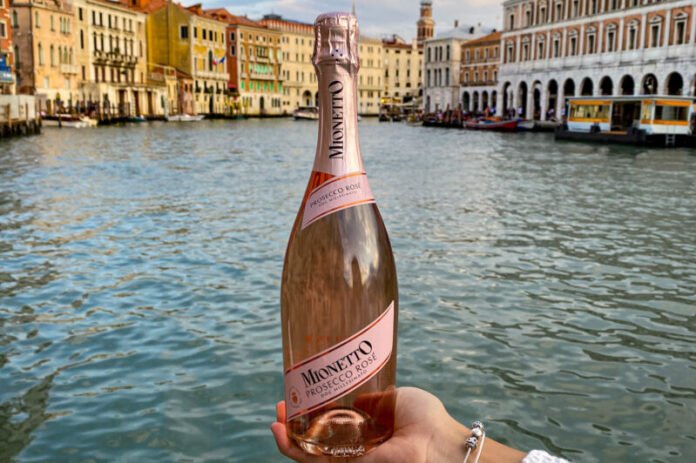I love sparkling wines. All of them: Prosecco, Cava, Champagne, Sekt… the list goes on. There’s something about holding a flute with a beautiful effervescent wine that gets us in celebration mode. I recently attended a virtual tasting to sample Prosecco Rosé DOC by Mionetto, one of the best-known Prosecco producers. This special Prosecco is summer in a glass, with its pale pink color and hints of berries. Prosecco is a: “Denominazione di Origine Controllata” (DOC), meaning the production has to come from a specific region (Veneto and Friuli Venezia Giulia). Mionetto is produced in Valdobbiadene, in the heart of the Prosecco area, just north of Venice. I also had the opportunity to have a Q&A with the CEO and Managing Director of Freixenet Mionetto USA, Enore Ceola, to learn more about Prosecco and their new product, Prosecco Rosé.
Q – What makes Prosecco Rosé DOC unique?
A – The launch of Prosecco Rosé marks a new era for the Prosecco category and fans, and Mionetto is excited to be at the forefront. Prior to the Prosecco Rosé DOC designation, Italian sparkling rosés weren’t regulated, meaning winemakers had flexibility on varietals and winemaking techniques. The challenge here is consumers didn’t know what to expect with every bottle they opened.
Having a Prosecco Rosé DOC as an official designation provides a sense of security and reassurance for Prosecco and Rosé fans and consumers.
Prosecco fans know what to expect with every bottle they open. You’re drinking a wine that’s made with a minimum of 85% Glera, which attributes to the wine’s fresh and fruity flavors. Prosecco Rosé DOC is also made with a minimum of 85% Glera (the remainder of the blend is Pinot Nero), so you’re getting similar flavor characteristics.
Mionetto’s flagship Prosecco DOC is 100% Glera (we’re purists) and our Prosecco Rosé DOC is a blend of 90% Glera and 10% Pinot Nero. This gives the delicate salmon color and red berry flavors! Mionetto’s distinctive Prosecco, and now Prosecco Rosé, captures a feeling. You hear the pop of the bottle, pour yourself and friends a glass, and know that you’re in for something fresh, fun, sophisticated, and distinctly Italian.
Q – As the summer approaches, what kind of food pairings do you recommend with Prosecco Rose?
A – Because Mionetto Prosecco Rosé is so light, crisp, and refreshing, it pairs wonderfully with grilled fish, cheeses, and creamy desserts. It’s also great on its own – poolside or rooftop sipping. It truly is summer in a bottle.

Q – For those dreaming of traveling back to Italy, can you recommend any highlights of the Prosecco region?
A – Mionetto Prosecco is produced in the steep hills of Valdobbiadene, situated mid-way between Venice and the Alps. This picturesque locale is the capital of the Prosecco wine region and is particularly lush, cool, and sunny. If you have a chance to visit, you will create memories to last a lifetime, and taste the freshest prosecco along with the area’s quality meats like Soppressa di Valdobbiadene and Prosciutto…
Q – What distinguishes Prosecco from other European sparkling wines such as Cava, Champagne or Sekt?
A – There are a few key differences: region, grape varieties and production methods. Prosecco is an Italian sparkling wine made primarily with Glera grapes and fermentation takes place in stainless steel tanks to preserve Glera’s freshness and aromatics. French Champagne can be made with any of the following varietals: Chardonnay, Pinot Noir and Pinot Meunier and the wine is fermented in bottle. This is a much more laborious process which explains the higher price point. Spanish Cava, like Champagne, is also fermented and aged in the bottle, but the varietals are Macabeo, Parellada and Xarel-lo. German Sekt is the lesser-known European sparkling wine. German Sekt is made using the tank method (like Prosecco) but can be a blend of any varietals.

Q – Over twenty years ago, you introduced Prosecco to the USA. What inspires you to do this work? Beyond enjoying the Prosecco, what do you think consumers should know about the product?
A – There was a time when all sparkling wines were referred to as ‘Champagne’ but as consumers increase their wine knowledge, they’re increasingly curious and exploring new categories, wines and pairings. While Champagne is commonly reserved for celebrations and special occasions – a festive wine if you will – consumers and wine drinkers are exploring alternate sparkling wines.
Inspired by the Italian lifestyle, where sparkling wine is part of the daily culture, I wanted to expand the sparkling wine moments beyond special occasions.
Given Prosecco’s approachability (flavor and price) and sophistication, it allows wine drinkers to experience the luxury of sparkling wine with every ‘pop’ of the cork, on any given day. No occasion required. Prosecco allows consumers to experience this everyday luxury, which is why I often refer to Prosecco as “champagne in blue jeans”.









